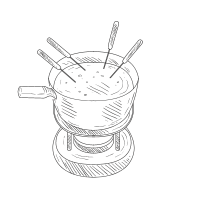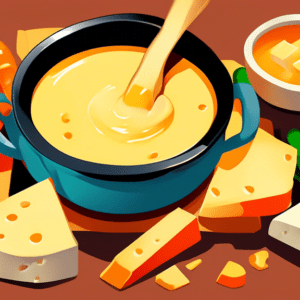What is Fondue?
Fondue, a word derived from the French verb fondre meaning to melt, is
more than just a meal—it’s an experience. Originating in Switzerland, this
communal dish features a pot of simmering liquid, typically cheese or
chocolate, kept warm over a portable stove. Diners use long-stemmed forks to
dip bite-sized pieces of food, like bread, vegetables, or fruit, into the
shared pot.
A Brief History of Fondue
Fondue’s roots trace back to the Swiss Alps, where it originated as a
practical and hearty meal for farmers during harsh winters. Using readily
available ingredients like aged cheese, wine, and bread, fondue provided
nourishment and warmth. It wasn’t until the 1930s that fondue gained
popularity beyond the Swiss borders, becoming a national dish and a symbol of
Swiss identity.
The Allure of Fondue: Beyond the Pot
Fondue’s appeal extends beyond its delicious simplicity. It fosters a
unique dining experience characterized by:
1. Conviviality and Connection
The act of sharing a pot of fondue naturally encourages conversation and
interaction among diners. As everyone gathers around the table, spearing
their chosen morsels and swirling them in the molten goodness, a sense of
camaraderie develops. The leisurely pace of a fondue meal allows for
extended conversations, laughter, and shared memories.
2. Culinary Creativity and Customization
Fondue is a culinary blank canvas, offering endless possibilities for
personalization. From the base itself to the dipping options, each element
can be tailored to individual preferences. Experiment with different cheeses,
infuse the base with herbs and spices, or offer an array of dipping choices,
from crusty bread to succulent meats and vibrant vegetables.
3. Entertainment and Engagement
Fondue transforms dining into an interactive activity. The process of dipping,
swirling, and savoring each bite adds an element of playfulness to the meal.
The anticipation of retrieving a perfectly coated morsel from the pot, the
delicate balance of dipping without losing anything to the depths below, and
the shared laughter over accidental drops all contribute to fondue’s
entertaining nature.
Crafting the Perfect Fondue Sauce: A Step-by-Step Guide
Making fondue sauce is easier than you might think. With a few simple
ingredients and some basic techniques, you can create a pot of molten
deliciousness that will impress your guests.
Choosing Your Cheese: The Foundation of Flavor
The type of cheese you choose will largely determine the flavor profile of
your fondue. Swiss cheeses like Gruyère and Emmental are traditional choices,
known for their nutty and slightly sweet notes. Gruyère lends a robust flavor
and excellent melting properties, while Emmental adds a touch of sweetness and
creates a smooth, creamy texture. For a bolder flavor, consider incorporating
Appenzeller, a Swiss cheese with a slightly sharp and spicy edge. Fontina, an
Italian cheese, can also be used, adding a more pungent and earthy dimension
to the fondue. Experiment with different cheese combinations to discover your
perfect blend.
Essential Ingredients:
-
Cheese: 1 pound, grated (Gruyère, Emmental, Appenzeller,
Fontina, or a combination) - Dry White Wine: 1 ½ cups
- Cornstarch: 1 tablespoon
- Lemon Juice: 1 tablespoon
- Garlic: 1 clove, halved
- Nutmeg: A pinch, freshly grated
- Black Pepper: To taste
Instructions:
-
Prepare the Fondue Pot: Rub the inside of a heavy-bottomed
pot or fondue pot with the cut side of the garlic clove. Discard the garlic. -
Combine Cheese and Cornstarch: In a large bowl, toss the
grated cheese with the cornstarch. This step helps prevent the cheese from
becoming stringy and ensures a smooth sauce. -
Heat Wine: Pour the white wine into the prepared pot and
heat over medium heat until it simmers gently. -
Add Cheese Gradually: Reduce the heat to low. Add the
cheese mixture to the simmering wine in small handfuls, stirring constantly
with a wooden spoon in a figure-eight motion. Wait until each handful of
cheese is melted and incorporated before adding more. This gradual heating
process ensures that the cheese melts evenly and creates a silky smooth
sauce. -
Stir in Lemon Juice: Once all the cheese has been
incorporated and the sauce is smooth, stir in the lemon juice. The acidity
of the lemon juice helps to balance the richness of the cheese and prevents
it from separating. -
Season and Serve: Season the fondue with nutmeg, black
pepper, and additional salt if needed. Transfer the fondue pot to a
fondue burner or a heat-proof trivet on the table to keep it warm.
Beyond the Cheese: Exploring Dipping Delights
The true joy of fondue lies in the dipping! Offer an array of options to
satisfy every palate.
Bread Basket Bonanza:
-
Crusty Bread: A fondue staple, crusty bread like baguette,
sourdough, or ciabatta provides a neutral base that beautifully absorbs the
flavorful cheese sauce. Cut the bread into bite-sized cubes for easy
dipping. -
Pretzel Bites: The salty crunch of pretzel bites offers a
delightful contrast to the creamy cheese. -
Breadsticks: Long, thin breadsticks are perfect for
swirling in the fondue and getting a generous coating.
Vegetable Medley:
-
Broccoli and Cauliflower Florets: These cruciferous
vegetables offer a satisfying crunch and a hint of sweetness when dipped in
cheese. -
Bell Peppers: Cut into strips, bell peppers add a burst of
color and a refreshing sweetness. -
Cherry Tomatoes: The acidity of cherry tomatoes cuts through
the richness of the cheese, creating a balanced bite. -
Mushrooms: Button mushrooms or cremini mushrooms absorb the
cheese sauce beautifully, adding an earthy flavor.
Protein Powerhouse:
-
Cooked Shrimp: The delicate flavor of cooked shrimp pairs
well with cheese fondue, creating an elegant appetizer. -
Ham Cubes: Salty ham cubes offer a savory counterpoint to
the creamy cheese. -
Cooked Chicken: Cut into bite-sized pieces, cooked chicken
is a satisfying and protein-rich dipping option.
Tips for Fondue Success:
-
Grate Your Own Cheese: While pre-shredded cheese is
convenient, grating your own cheese from a block will result in a smoother,
creamier fondue. Pre-shredded cheese is often coated with cellulose, which
can inhibit melting. -
Use Dry White Wine: The acidity in dry white wine helps
break down the cheese and create a smooth sauce. Avoid using sweet wines, as
they can make the fondue overly sweet. -
Low and Slow: The key to a successful fondue is to melt
the cheese slowly and gradually over low heat. High heat can cause the
cheese to separate and become stringy. -
Keep it Moving: Stir the fondue frequently, especially as
you add the cheese. This will prevent it from sticking to the bottom of the
pot and ensure that it melts evenly. -
Don’t Overcrowd the Pot: When dipping, avoid overloading
your fork. This will prevent food from falling into the pot and breaking
the cheese sauce. -
Embrace the Crust: The crispy, cheesy crust that forms at
the bottom of the pot is a delicacy known as la religieuse (the nun) in
French. It’s considered good luck to scrape it off and share it at the end
of the meal.
Fondue: A Culinary Adventure Awaits
Fondue is more than just a meal; it’s an immersive experience that brings
people together. From the communal pot to the endless dipping possibilities,
fondue offers a unique and interactive way to enjoy delicious food and create
lasting memories. So gather your loved ones, fire up the fondue pot, and
prepare for an unforgettable culinary adventure.

